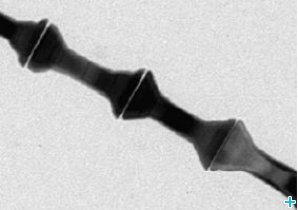How to probe tiny samples? Insights into the production of micron-sized cold neutron beams
The NMI3 Imaging JRA discusses how to produce smaller beams. They conclude that reflective optics offers the most versatile way to produce them.
NMI3, 09/07/2015
Neutron beams for condensed matter studies are traditionally big, macroscopic beams, mostly because of the limited neutron flux. However to probe small samples with a high spatial resolution by neutron imaging, it is necessary to use micro-sized (1–50 µm) thermal or cold neutron beams. A group of scientists from France, Russia and Spain have just published a paper where they discuss various possibilities to produce such micro-sized neutron beams. This work is conducted within the NMI3 Imaging Joint Research Activity .
In the paper they describe three ways of producing sub-100 µm thermal neutron beams by using:
- collimation slits
- reflected beams
- neutron waveguides
They concluded that reflective optics offers the most versatile way to produce tiny neutron beams while also enhancing signal-to-background ratio. With this technique the size of the micro-beam can be easily tuned by simply rotating the reflecting mirror. Being able to work off the direct beam provides an excellent signal/noise ratio even if the incident neutron intensities are low. The scheme will be tested on the new radiography station IMAGINE at the Laboratoire Léon Brillouin in France.
Original Publication
F. Ott, S. Kozhevnikov, A. Thiaville, J. Torrejon, M. Vázquez (2015), Shaping micron-sized cold neutron beams, Nuclear Instruments and Methods in Physics Research Section A, 788, 29–34, doi:10.1016/j.nima.2015.03.057

This work is supported by NMI3 through the Imaging JRA.
NMI3 Imaging articles
JRA Series: Imaging – Neutrons help visualising materials
New imaging methods will offer new possibilities to physicists, material scientists, engineers, palaeontologists, archaeologists, and others, so that they can obtain better information on their objects of study. See our video and article here!
JRA series: Imaging at BNC
Watch Zoltán Kis and László Szentmiklósi from the BNC describe their work as part of the Imaging JRA. To see the video click here.
Neutrons show that 260 million years ago the Pristerodon could already hear airborne sound
Neutron tomography experiments revealed that some forerunners of mammals were already able to hear airborne sound thanks to an eardrum at the lower jaw, an impedance matching middle ear and a small cochlea. Read more.




